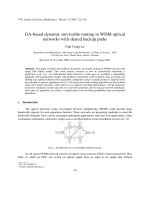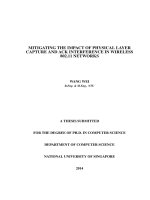survivability and traffic grooming in wdm optical networks
Bạn đang xem bản rút gọn của tài liệu. Xem và tải ngay bản đầy đủ của tài liệu tại đây (9 MB, 459 trang )
SURVIVABILITY AND TRAFFIC GROOMING
IN WDM OPTICAL NETWORKS
The advent of fiber optic transmission systems and wavelength-division multiplex-
ing (WDM) have led to a dramatic increase in the usable bandwidth of single-fiber
systems. This book provides detailed coverage of survivability (dealing with the
risk of losing large volumes of traffic data due to a failure of a node or a single fiber
span) and traffic grooming (managing the increased complexity of smaller user
requests over high-capacity data pipes), both of which are key issues in modern
optical networks.
A framework is developed to deal with these problems in wide area networks,
where the topology used to service various high-bandwidth (but still small in rela-
tion to the capacity of the fiber) systems evolves toward making use of a general
mesh. Effective solutions, exploiting complex optimization techniques and heuris-
tic methods are presented to keep network problems tractable. Newer networking
technologies and efficient design methodologies are also described.
This book is suitable for researchers in optical fiber networking and designers
of survivable networks. It would also be ideal for a graduate course on optical
networking.
Arun K. Somani is the Jerry R. Junkins Endowed Chair Professor of Electrical
and Computer Engineering at Iowa State University. His research interests are in the
area of fault-tolerant computing, computer interconnection networks, WDM-based
optical networking, and parallel computer system architecture. He has served as an
IEEE distinguished visitor and an IEEE distinguished tutorial speaker. He has been
elected a Fellow of the IEEE for his contributions to the theory and applications of
computer networks.
SURVIVABILITY AND TRAFFIC
GROOMING IN WDM
OPTICAL NETWORKS
ARUN K. SOMANI
cambridge university press
Cambridge, New York, Melbourne, Madrid, Cape Town, Singapore, São Paulo
Cambridge University Press
The Edinburgh Building, Cambridge cb2 2ru,UK
First published in print format
isbn-13 978-0-521-85388-0
isbn-13 978-0-511-13754-9
© Cambridge University Press 2005
2005
Informationonthistitle:www.cambrid
g
e.or
g
/9780521853880
This publication is in copyright. Subject to statutory exception and to the provision of
relevant collective licensing agreements, no reproduction of any part may take place
without the written permission of Cambridge University Press.
isbn-10 0-511-13754-0
isbn-10 0-521-85388-5
Cambridge University Press has no responsibility for the persistence or accuracy of urls
for external or third-party internet websites referred to in this publication, and does not
guarantee that any content on such websites is, or will remain, accurate or appropriate.
Published in the United States of America by Cambridge University Press, New York
www.cambridge.org
hardback
eBook (NetLibrary)
eBook (NetLibrary)
hardback
This book is dedicated to my parents, who have been an inspiration towards my
achievements in life, and to all my students who helped turn my dream into a
reality and my family who supported me unconditionally.
Contents
Preface page xiii
Acknowledgments xix
1 Optical networking technology 1
1.1 Wavelength-division multiplexing 2
1.2 Broadcast-and-select networks 4
1.3 Wavelength-routed WDM networks 7
1.4 Wavelength conversion in WDM networks 10
1.5 Optical packet switching 12
1.6 Optical burst switching 12
1.7 The rest of the book 13
2 Design issues 14
2.1 Network design 14
2.2 Network model 15
2.3 Routing and wavelength assignment 17
2.4 Multi-fiber networks 23
2.5 Survivability 25
2.6 Restoration methods 26
2.7 Traffic grooming in WDM networks 28
2.8 Optical packet switching 30
2.9 Optical burst switching 31
3 Restoration approaches 34
3.1 Restoration model 38
3.2 Upgradeable network design 38
3.3 Notation 40
3.4 Cost model 41
3.5 Design problem 44
3.6 Heuristic approach for network design 51
vii
viii Contents
3.7 Network upgrade 55
3.8 Methodology validation 56
4 p-cycle protection 62
4.1 Design of p-cycle restorable networks 62
4.2 Cycle selection algorithms 63
4.3 Joint optimization of p-cycle design 66
4.4 A p-cycle-based design for dynamic traffic 66
4.5 Algorithm for finding all cycles 82
5 Network operation 86
5.1 Capacity minimization 86
5.2 Revenue maximization 87
5.3 Capacity minimization: problem formulation 88
5.4 Revenue maximization: problem formulation 90
5.5 Solution methodology 93
5.6 Performance evaluation 95
6 Managing large networks 102
6.1 Online algorithm 102
6.2 Example 105
6.3 LP formulation 106
6.4 Solving for excess demands 110
6.5 Quality of the LP heuristic algorithm 110
6.6 ILP and LP solution run times 113
6.7 Run times for the LP heuristic algorithm 115
7 Subgraph-based protection strategy 116
7.1 Subgraph-based routing and fault tolerance model 117
7.2 Performance of subgraph-based routing 119
7.3 Performance results 123
7.4 Multi-link and other failures 127
7.5 Constrained subgraph routing 130
7.6 Example 131
7.7 Observations 140
8 Managing multiple link failures 143
8.1 Link-based protection for two link failures 144
8.2 Path-based protection 147
8.3 Formulating two link failures 148
8.4 Examples and comparison 155
8.5 Dual-link failure coverage of single-failure protection schemes 157
8.6 Dual-link failure coverage using shared-mesh protection 159
8.7 Dual-link failure coverage: subgraph routing 161
Contents ix
8.8 Coverage computation 163
8.9 Observations 167
9 Traffic grooming in WDM networks 169
9.1 Traffic grooming in WDM rings 173
9.2 Static traffic grooming in rings 173
9.3 Dynamic traffic grooming in WDM networks 178
10 Gains of traffic grooming 184
10.1 Network parameters 185
10.2 Modeling constrained grooming networks 186
10.3 Sparse grooming network 194
10.4 Validation of the model 195
11 Capacity fairness in grooming 201
11.1 Managing longer paths 202
11.2 Capacity fairness 203
11.3 Fairness performance of RWA algorithms 205
11.4 Connection admission control for fairness 206
12 Survivable traffic grooming 210
12.1 Traffic stream multiplexing on a single wavelength
link 211
12.2 Grooming traffic streams on the network 213
12.3 Routing and wavelength assignment 216
12.4 Effect of traffic grooming 218
13 Static survivable grooming network design 224
13.1 Design problem 224
13.2 Example 231
14 Trunk-switched networks 236
14.1 Channels and trunks 236
14.2 Modeling a WDM grooming network as a TSN 237
14.3 Node architecture 238
14.4 Free and busy trunks 241
14.5 Connection establishment 243
14.6 Grooming network model 246
14.7 MICRON framework 247
14.8 A two-pass approach 252
14.9 Modeling a channel-space switch in MICRON 257
15 Blocking in TSN 261
15.1 Blocking model 261
15.2 Estimation of call arrival rates on a link 262
15.3 Path blocking performance 264
x Contents
15.4 Free trunk distribution 269
15.5 Modeling switches 273
15.6 Heterogeneous switch architectures 274
15.7 Improving the accuracy of the analytical model 278
16 Validation of the TSN model 280
16.1 Simulation setup 281
16.2 Homogeneous networks performance 282
16.3 Heterogeneous networks performance 287
16.4 Observations 292
17 Performance of dynamic routing in WDM grooming
networks 293
17.1 Information collection 293
17.2 Path-selection algorithms 296
17.3 An example 298
17.4 Performance of routing algorithms 298
17.5 Experimental setup 299
18 IP over WDM traffic grooming 309
18.1 IP traffic grooming in WDM networks 311
18.2 IP traffic grooming problem formulation 313
18.3 Solution for an optimal strategy 315
18.4 Approximate approach 318
18.5 Traffic aggregation algorithm 318
18.6 Example of traffic aggregation 321
18.7 Performance study 324
18.8 Examples 325
19 Light trail architecture for grooming 330
19.1 Light trail 330
19.2 Node structure 331
19.3 Light trail characteristics 333
19.4 Light trail design 334
19.5 Solution considerations 337
19.6 Light trail hop-length limit: Tl
max
= 4 343
19.7 Light trail hop-length limit: Tl
max
= 5 346
19.8 Restoration in the light trail architecture 347
19.9 Survivable light trail design 350
19.10 ILP formulation: connection-based protection 350
Appendix 1 Optical network components 357
Appendix 2 Network design 377
Appendix 3 Graph model for network 390
Contents xi
Appendix 4 Graph algorithms 393
Appendix 5 Routing algorithm 406
Appendix 6 Network topology design 408
References 416
Index 434
Preface
Before the 1970s, networks were primarily used to carry voice or telephone calls
over circuit-switched networks. Failures and service outages in such transport net-
works were handled mainly at the circuit layer, and many a time manually. Most
of the remedial actions included routing of the call by manual configuration of
switches by network operators. Over time the capacity of the transport networks
increased, data overlay networks were created and a large number of end-users
instituted private voice and packet networks.
With the advent of fiber optic transmission systems and eventually wavelength-
division multiplexing (WDM) the bandwidth of a single fiber soared. With increas-
ing deployment of fibers in networks, the risk of losing large volumes of traffic due
to a span cut or a node failure has also increased tremendously. In the 1990sBellcore
developed the SONET (synchronous optical network) standard and standardized
the concept of self-healing rings. It was soon followed by the equivalent standard
named SDH (synchronous digital hierarchy) in Europe. This appeared to be the
final solution. Many service providers could replace all of their cumbersome and
expensive point-to-point transmission systems with a few multi-node, self-healing
SONET rings. Many carriers joined the SONET ring bandwagon.
With further developments in technology, more and more mesh-network topolo-
gies started emerging. Failure management still remained a part of the solution and
recovering from them remained a challenging issue. It soon started to fuel the ev-
erlasting question that still prevails to this day: which is a better option, ring-based
or mesh-based restoration? Over the years, as the traffic increased a mesh-based
approach seemed to be a more viable option for providing restoration, compared to
a traditional ring network. There are different tradeoffs between ring and mesh
restoration. In a ring network, once the network is installed the restoration is
automatic. In contrast, in a mesh network, most of the control is in the hands
of a centralized control system, and hence it makes the control very complicated.
This motivated the need for intelligent network elements which are capable of
xiii
xiv Preface
distributed routing, detecting failures of the links and passing topology update
information amongst adjoining nodes using variations of link state protocols.
Another important element of the architecture is when and how much to do
to recover at the time of establishing a connection. The range of options varies
from identifying and provisioning the resources for recovery to take care of failure
at the time of establishing the connection, to identifying all resources to recover
when a failure occurs. The former is called protection and the latter is an extreme
in restoration. In between options include identifying an alternate path only for
a connection being established, identifying an alternate path and resources to be
used on the path but not activate the path, or even activating the resources but not
using them. Each option presents a different cost and impact on functionality of the
network.
In present-day networks, SONET rings are more prevalent in metropolitan net-
works, where there is less geographic diversity, whereas mesh-based networks are
more common in ultra-long-haul networks covering areas of vast geographical vari-
ations. Also, as optical cross-connects and WDM switching technologies mature,
mesh-based restoration for pure optically switched networks are of increased inter-
est because of the reduced costs of optical–electrical conversion and the economics
of scale for integration of WDM and electronics.
Another important debate that has not been settled is which layer in networking
should be responsible for protection and/or restoration. At the present time the
internet protocol (IP) is the dominant mode of internetworking. The IP layer has
its own protection and restoration strategy. For each destination, a source may
have many possible paths and may choose to have a preferred path for routing
packets to that destination. At the optical or physical network level, a network
designer may adopt a strategy to recover from a complete fiber failure. On the
other hand, many IP routes may be routed through the same fiber as a fiber does
support many channels, each being used for a different IP route. Thus, a single
fiber failure may result in multiple IP route failures. Moreover, optical networks
use the concept of a virtual topology, in which most commonly used routes may
be created using a concatenation of channels on multiple fibers. The IP layer may
not even be aware of how the physical network has been utilized to create a virtual
topology. Hence IP routing and restoration have some pitfalls. It is not clear which
strategy or a combination of the two is better. It is believed by many researchers that
protection/restoration at the WDM layer is more advantageous, but this is disputed
by those who prefer IP protection/restoration.
This brings us to one of the two most important contributions of this book.
We attempt to provide a brief overview of different optical networking trends
and technologies followed by different network design and restoration architec-
tures in mesh-restorable optical networks. Several chapters are devoted to studying
Preface xv
various protection and restoration architectures, methods to model the problem,
and algorithms to design functionality and operational aspects, and to study the
performance of various schemes.
Another important problem in optical fiber networks with wavelength-division
multiplexing is that of traffic grooming. The capacity of a single wavelength channel
has been increasing constantly, reaching the level of 10–40 GHz/channel. At the
same time individual user requirements are not increasing at the same pace, although
the overall number of users and applications are increasingly dramatically. Thus,
it is important to accommodate all the applications while utilizing the resources
efficiently. The traffic grooming problem presents a whole new set of challenging
problems.
The second half of the book focuses on traffic grooming. Traffic grooming is a
technique for multiplexing different subwavelength capacity traffic requirements
onto a single wavelength so that the wavelength and hence the capacity requirements
of the whole network are minimized.
This book is written with two main communities in mind.
One of them consists of my colleagues in industry, research scientists, technol-
ogy planners, network designers, and also corporate research laboratories. They
are incessantly striving to access the economics of different architectural decisions
and standards devolvement. Network operators are in a fiercely competitive mar-
ket, striving for more and more productivity. Mesh networking studied in this book
provides them with great productivity enhancements through greater network effi-
ciencies and flexibility. Developers of network modeling, simulation, and network
planning would be interested in many of the ideas presented in this book. Incor-
porating capabilities to design all types of architecture alternatives, and accessing
the merits and demerits of each chosen alternative, the book fuels the interest of
different network researchers.
The second main community who would benefit from this book are graduate-
level teachers and researchers who want a self-contained volume to derive insights
into aspects of transport network design and also to use this to teach a graduate-level
course on optical networking. I expect both communities to benefit equally. Any
designer of a new graduate course will hopefully continuously upgrade the material
with more advanced developments as the technology improves.
In the following, the flow of the contents in the book is explained.
Chapters 1 and 2 serve as introductory chapters to networking using fiber op-
tics technology and the rest of the book. Since the book specializes on two most
important topics, understanding the rest of the concept is important. For that rea-
son, these chapters serve as an introduction to wavelength-division multiplexing,
broadcast-and-select-network designs, and different optical networking trends and
technology. They also introduce several interesting aspects and issues in the design
xvi Preface
of such networks, which include the routing and wavelength assignment prob-
lems, optical packet switching and optical burst switching, traffic grooming and
survivability in mesh restorable optical networks, and survivable traffic grooming
in optical networks.
The book then moves on to discuss different restoration approaches and also
the upgradeable network design problem. The whole concept is treated within a
survivability framework. Mesh restoration architectures have natural ties into the
network design problem. It can be viewedas a network design and network operation
problem. The problem can be formulated using different scenarios and that subject
is dealt with in the next chapter. Different formulations and heuristic approaches to
solving the network design problems are discussed in Chapter 3. Chapter 4 deals
with an alternate approach, called the p-cycle or protection cycle. This strategy
allows the use of similar protection algorithms to those designed for ring networks
in mesh-like architectures.
Chapter 5 concentrates on network operation. There are two important goals
in network operation. The network can be optimized to use minimal capacity out
of that available to serve the offered demand, assuming that the demands are not
greater than the capacity. The goal here is to keep as much capacity free as possible
to accommodate future requests. Alternately, the demands offered may be more than
the available capacity. In that case, the goal is to optimize the operation and accept
those requests that would maximize the service providers’ gain. Depending on the
gain matrix chosen, the optimization can be tuned to serve a specific aspect. The
details of such operational optimizations are discussed in the form of the capacity
minimization and the revenue maximization subproblems.
The optimization problems formulated in Chapter 5 are complex and difficult to
solve in real time. We continue to discuss different relaxation techniques that can
be applied to solve the integer linear programming (ILP) problems in Chapter 6.
The goal here is to adopt those techniques that will result in a near-optimal solution
while minimizing the required computation time. Some insight into the formulation
is developed and used to derive near-optimal or optimal solutions while keeping
the commutation time under control for near real-time and real-time on-line appli-
cations.
In Chapter 7, we discuss how to tolerate multiple link failures in a network. The
problem is reviewed in detail and some solutions are studied. We also present an ILP
approach to solve the dual-link failure problem in a WDM network. Several other
techniques for solving the multi-link failure protection and restoration problem are
also presented.
In the following chapter, Chapter 8, we present another approach called the
subgraph-based routing strategy in mesh-restorable WDM optical networks. In this
Preface xvii
scheme no resources are reserved for protection. However, provision is made to
make sure that all resources are available when an actual failure indeed occurs. It
is demonstrated how subgraph routing can be used to protect a network against
multiple-link and node group failures.
Chapter 9 introduces the concept of traffic grooming in WDM optical networks.
Both static and dynamic traffic grooming concepts are presented. The chapter also
discusses techniques for static traffic grooming in rings and presents the advantages
of and issues in traffic grooming in WDM rings.
Chapter 10 presents a model to study the advantages of traffic grooming and
quantifies the gains of traffic grooming. An analytical model of a WDM grooming
network is presented for grooming on a single wavelength on a single- and a multi-
hop path. The model also discusses the type of network where all or some of the
nodes in the network may be capable of grooming.
One of the important issues in any traffic grooming is that of fairness. Since
users may request different capacities, it is important that all requests are handled
fairly based on chosen criteria. Although fairness means different things to different
people, we present a model of fairness in Chapter 11 that we use in this work and
evaluate the fairness of various routing and wavelength assignment algorithms used
in WDM grooming networks.
Chapters 12 and 13 bring the two topics, survivability and traffic grooming, to-
gether. In Chapter 12, we discuss survivable grooming network design. Both routing
and wavelength selection issues for survivable traffic grooming are presented and
solutions are developed to utilize resources effectively in such networks. Chap-
ter 13 deals with the design of networks that support static traffic grooming with
survivability.
In the second part of the second topic, a new framework for dealing with traffic
grooming is presented. This framework, called a trunk-switched network, presents
a methodology to represent and analyze traffic grooming. The framework is a
powerful one, which can support modeling of various traffic grooming mechanisms
and analyze them. Chapter 14 presents the framework and modeling methodology
for a WDM traffic grooming network. The next chapter, Chapter 15, is devoted to
use of the network for performance analysis. Chapter 16 is devoted to validating
the model and includes several examples to demonstrate the applications of trunk-
switched WDM grooming networks. Both sparse and dense networks (defined based
on the number of nodes that support traffic grooming) as well as homogeneous
and heterogeneous networks (defined based on the type of grooming nodes being
identical or different) are managed.
Chapter 17 is devoted to traffic routing and wavelength assignment algorithms
in a traffic grooming network. Several algorithms are presented and analyzed.
xviii Preface
Chapter 18 presents traffic grooming in an IP-over-WDM network. This is an
important area as both IP and WDM have to eventually work together. Algorithms
to route IP traffic efficiently over a WDM network are presented and analyzed.
The final chapter, Chapter 19, presents an innovative technique called the light
trail architecture, which is used for traffic grooming in WDM optical networks
for local and metropolitan areas and has the potential to integrate with wide area
networking. It also discusses how restoration can be achieved in the light trail
architecture and presents an ILP formulation for the survivable light trail design
problem.
Additional material in a few appendices would help researchers from various
communities to develop interest in the topic of survivability and traffic grooming
in optical networks. The goal is to create a highly useful and interesting book that
is imbued with new options and insights for industry and academia to enjoy and
benefit from.
Acknowledgments
A work of this magnitude is a result of encouragement from and the efforts of many
people.
First, there has to be inspiration. My father, a visionary, had provided me with a
gift that I only appreciated after he passed away. Right from the beginning, he kept
me focused on achieving the best and continuing to strive until a goal is achieved. He
pushed me into situations where the chances of failures were high and encouraged
me to succeed. Part of the reason for him probably was that he had to give up his
studies sooner than he wanted or needed to. He fulfilled that dream of his through his
children and felt his success through us, his children. I have been a tutor right from
my third/fourth grade. Not only encouraging us in academics, he also continuously
strived to make us good citizens and to help others.
Whenever he felt weak, such as when I had to leave home for college, my mother
took charge. The encouragement from the two of them has resulted in what I am
today. I am indebted to them.
And then my students, who were always full partners in the work I produced. I
was blessed with excellent graduate students who always challenged me and kept
me on my toes. Although I had many students working with me in many different
areas, this work is mainly representative of the work I performed with Suresh Subra-
maniam, Ling Li, Sashisekhran Thiagarajan, Srinivasan Ramasubramanian, Murari
Sridharan, Tao Wu, Jing Fang, Pallab Datta, Mike Fredericks, Nathan Vanderhorn,
Wensheng He, Srivatsan Balasubramaniam, Nitin Jose, and Yana Ong, who have
contributed to this work in many ways. The contribution made by each of them is
great. They deserve a rich appreciation.
Among my colleagues, I was blessed to have worked with many good people.
James A. Meditch initially inspired me to start looking at problems in this area.
Murat Azizoglu was a great colleague to work with. Later on Ahmed Kamal, Robert
Weber, and Mani Mina have been great allies. I never hesitated in asking them for
any help, academic or otherwise, which I always received. Thanks go to all of them.
xix
xx Acknowledgments
Finally, my wife, Manju, who never questions me when I return from the office
and always tolerates any amount of my work frustration. Religiously she packs
my lunch every morning at 7:30 a.m. and reminds me every evening, including
most weekends, that it is 7:00 p.m. and I might be hungry. She always took care of
the kids and provided the support they needed from both of us. My kids love me
unconditionally, irrespective of the amount of time I found for them.
My special thanks to Pallab who has really assisted me in organizing the material
in the book into its current shape. Without him, I have no idea when I would have
been able to finish it.
It has been a real blessing to be surrounded by friends, colleagues, students, and
family as I have. I am indeed thankful to all of them.
1
Optical networking technology
Technological advances in semiconductor products have essentially been the pri-
mary driver for the growth of networking that led to improvements and simplifica-
tion in the long-distance communication infrastructure in the twentieth century. Two
major networks of networks, the public switched telephone network (PSTN) and the
Internet and Internet II, exist today. The PSTN, a low-delay, fixed-bandwidth net-
work of networks based on the circuit switching principle, provides a very high qual-
ity of service (QoS) for large-scale, advanced voice services. The Internet provides
very flexible data services such as e-mail and access to the World Wide Web. Packet-
switched internet protocol (IP) networks are replacing the electronic-switched,
connection-oriented networks of the past century. For example, the Internet
is primarily based on packet switching. It is a variable-delay, variable-bandwidth
network that provides no guarantee on the quality of service in its initial phase.
However, the Internet traffic volume has grown considerably over the last decade.
Data traffic now exceeds voice traffic. Various methods have evolved to provide
high levels of QoS on packet networks – particularly for voice and other real-time
services. Further advances in the area of telecommunications over the last half a
century have enabled the communication networks to see the light. Over the 1980s
and 1990s, research into optical fibers and their applications in networking revo-
lutionized the communications industry. Current telecommunication transmission
lines employ light signals to carry data over guided channels, called optical fibers.
The transmission of signals that travel at the speed of light is not new and has been in
existence in the form of radio broadcasts for several decades. However, such a trans-
mission technology over a guided medium, unlike air, with very low attenuation
and bit-error rates makes optical fibers a natural choice for the medium of commu-
nication for next-generation high-speed networks. The first major change with the
development of the fiber technology was to replace copper wires by fibers. This
change brought high reliability in data transmission, improved the signal-to-noise
ratio and reduced bit-error rates.
1
2 Optical networking technology
Fig. 1.1. A next-generation network architecture.
With the advent of optical transmission technology over optical fibers, the com-
munication networks have attained an orders of magnitude increase in the network
capacity. This development had a tremendous and dramatic impact on social and
economic aspects of the lives of people around the world [1, 3, 4, 5]. With increasing
data traffic and high QoS requirements on packet networks, it is becoming desir-
able to bring together various different networks around a single packet-based core
network. The next-generation network (NGI) architectures are converging to share
a common high-level architecture as shown in Fig. 1.1. It would integrate multiple
different networks, e.g., PSTN, IP, ATM (asynchronous transmission mode), and
SONET (synchronous optical networks)/SDH (synchronous digital hierarchy), etc.
based networks into a single framework.
Initially, the migration from electronic to optical transmission technology was
achieved by only replacing copper cables with optical fibers. Traditional time-
division multiplexing (TDM) that allows multiple users to share the bandwidth of
a link was employed. In TDM, the bandwidth sharing is in the time domain. Multi-
plexing techniques specific to optical transmission technology were not employed
in the early networks. The synchronous optical network is the most popular network
in this category. SONET is based on a ring-architecture, employing circuit-switched
connections to carry voice and data traffic. The second-generation optical network
uses wavelength-division multiplexing (WDM) which is similar to frequency-
division multiplexing (FDM).
1.1 Wavelength-division multiplexing
The optical transport layer is capable of delivering multi-gigabit bandwidth with
high reliability to the service platforms. The bandwidth available on a fiber is
1.1 Wavelength-division multiplexing 3
Fig. 1.2. A fiber divided among multiple wavelengths.
approximately 50 THz (terahertz). Increasing the transmission rates could not be
adopted as the only means of increasing the network capacity. Transmission rates
beyond a few tens of gigabits per second could not be sustained for longer distances
for reasons of impairments due to amplifiers, dispersion, non-linear effects of fiber,
and cross-talk. Hence, wavelength-division multiplexing was introduced, which
divided the available fiber bandwidth into multiple smaller bandwidth units called
wavelengths.
The WDM-based networking concept was derived from a vision of accessing a
larger fraction of the approximately 50 THz theoretical information bandwidth of a
single-mode fiber. A natural approach to utilizing the fiber bandwidth efficiently is to
partition the usable bandwidth into non-overlapping wavelength bands. Each wave-
length, operating at several gigabits per second, is used at the electronic speed of the
end-users. The end-stations thus can communicate using wavelength-level network
interfaces. Wavelength-division multiplexing turns out to be the most promising
candidate for improving fiber bandwidth utilization in future optical networks.
Figure 1.2 depicts the WDM view of a fiber link. The research, development, and
deployment of the WDM technology evolved at a rapid pace to fulfill the increasing
bandwidth requirement and deploy new network services.
The wavelength-division multiplexing mechanism divides the bandwidth space
into smaller portions. Hence, the multiplexing is said to occur in the space domain.
Different connections, each between a single source–destination pair, can share
the available bandwidth on a link using different wavelength channels. Advanced
features such as optical channel routing and switching supports flexible, scalable,
and reliable transport of a wide variety of client signals at ultra-high speed. This
next-generation network concept dramatically increases, and maximally shares, the
backbone network infrastructure capacity and provides sophisticated service differ-
entiation for emerging data applications. Transport networking enables the service
layer to operate more effectively, freeing it from the constraints of physical topology
to focus on the sufficiently large challenge of meeting the service requirements.
The application signals have widely varying characteristics, e.g., signal format,
type of signal, and transmission speed. To transport the varied application signals
4 Optical networking technology
Fig. 1.3. A broadcast-and-select network.
over the optical transport network, a network service layer is needed to map the
signals to optical channel signals along with an associated “overhead” to ensure
proper networking functions. This layer, for example, captures today’s IP and ATM
capabilities with statistical multiplexing and a QoS guarantee. Protocols such as
multi-protocol label switching (MPLS), resource reservation protocol (RSVP), and
differentiated services (DiffServ) play a major role in supporting the required QoS
across a wide set of applications. The network service layer relies entirely on the
transport layer for the delivery of multi-gigabit bandwidth where and when it is
needed to connect to its peers.
1.2 Broadcast-and-select networks
Early optical networks employed broadcast-and-select technology. In such net-
works, each node that needs to transmit data broadcasts it using a single wave-
length and the receiving node selects the information it wants to receive by tuning
its receiver to that wavelength. In a WDM network, many nodes may transmit simul-
taneously, each using a different wavelength on the same fiber or passing through
the same node. A broadcast star architecture as shown in Fig. 1.3 is an example of
such a network.
Nodes in the broadcast-and-select networks are connected by links and optical
couplers. An optical coupler is a passive component that is used for either combining
or splitting the signals into or from a fiber. The couplers can be configured to
split/combine signals in specific ratios so as to achieve a proper energy mix/split.
The central coupler in Fig. 1.3 couples all of the energy transmitted by all nodes
and splits the combined energy equally among all receivers.
It should be evident that the data transmitted by a node is received by all other
nodes. Every node only uses the data that is destined for it and discards the rest.









